
31 May The Answer to One Question Should Guide Your Web Design Solution
On this Web Designers day, I don’t want to talk about trends for 2018. You can just Google “web design trends for 2018” or “user experience trends for 2018.” I also don’t want to talk about artificial intelligence or virtual reality. No, what I want to discuss is what we, at The Bowen Group, consider the very foundation of good design…the ability to listen. Trends are cool but if applied incorrectly, you will never truly connect with your users. The Bowen Group applies the following methodology to every project we take on.
Who is your user and what is their problem?
At the start of any project, we ask a simple question. “What is the problem we are trying to solve?” If you start with that question, the outcome will inevitably meet your user’s needs. Remember, good design is creating meaningful experiences for our users through problem solving.
How should we approach the solution?
Should you apply user experience design principles or human-centered design principles? Should you apply both? Both design principles focus on solving problems for users. What is the difference between the two? In a nutshell:
- Human-centered design is a framework that considers human perspectives throughout the design process. It is not exclusive to any design discipline.
- User experience design applies a human-centered approach to creating designs that enhance user satisfaction with a product by improving the usability, accessibility, and pleasure provided in the interaction with the product.
At The Bowen Group, we apply both. By putting ourselves in the user’s shoes and empathizing with them, we are able to create products and services that meet their needs and, most importantly, solve problems!
Create solutions to solve problems.
Experience over product is key! Too often designers get lost in the desire to apply the latest trends to whatever they are creating and forget to simply solve the user’s problem.
Deliver solutions that are accessible to all.
We deliver solutions for all users. At The Bowen Group, we pride ourselves in ensuring that accessibility is at the forefront of each project.
Did we actually solve the problem?
Meeting the needs of users does not end with the launch of a website or delivery of a product. It is an iterative process of continued listening and adjusting to meet the user’s needs.
How can we put this into practice? The Web Services Team at The Bowen Group has been taking a Human Centered Design class. To put what we were learning to everyday practical use, one of our first challenges was to help improve our teammate’s commute.
Who is your user and what is their problem?
I asked my teammate to describe her commute to include her morning routine, when she left home, the route she took, any alternative routes she could take and how she felt during her commute.
How should we approach the solution?
I listened and then asked, “What is the problem we are trying to solve?” It turns out my teammate was fairly satisfied with the length of her commute but was more frustrated with simply being in the car. If only all the other drivers would pay attention and stay out of her way.
Create solutions to solve problems.
This problem was not going to be solved by simply rerouting her commute or altering her start time. I needed to put myself in her shoes and find a way to make the commute more enjoyable for her.
Deliver solutions that are accessible to all.
That is where Harry Potter comes into play. I discovered that my teammate loves Harry Potter and loves to read. So why not combine those two “loves” and use them to solve her frustration with the commute by having her listen to a audio book.
Did we actually solve the problem?
I have not validated this solution yet as we are just finishing the delivery phase. But we understand that this will be an iterative process of continued listening and adjusting to improve her daily commute.
In the immortal words of Ron Weasley, “Don’t let the muggles get you down.” And from The Bowen Group to you, don’t start a project until you can answer one simple question…
“What is the problem you are trying to solve?”
* What’s the Difference Between Human-Centred Design and User Experience Design?

